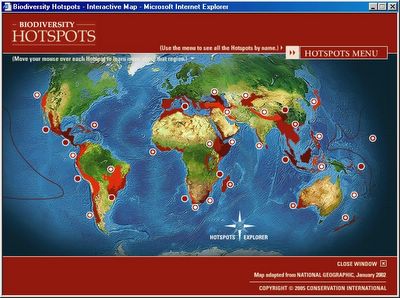Bord de Mahajanga
bord de mahajanga, lay tanana mamiko, tanindrazako tiako, madagasikara madagascar my beloved country, come to visit it and you will be happy. Toerana mamy sy manantantara misy fitiavana sy fiadanana
Monday, May 16, 2005

Biodiversité
Madagascar anisan'zay mahaliana ny maro
Madagascar and its neighboring island groups have an astounding total of eight plant families, four bird families, and five primate families that live nowhere else on Earth. Madagascars more than 50 lemur species are the islands charismatic worldwide ambassadors for conservation, although, tragically, 15 more species have been driven to extinction since humans arrived. The Seychelles, Comoros and Mascarene islands in the Indian Ocean between them support a number of Critically Endangered bird species. The Seychelles are also home to the only endemic family of amphibians: the Sooglossidae, and the Aldabra giant tortoise, one of the regions most heralded endemic reptiles. Hotspot Original Extent (km2) 600 461 Hotspot Vegetation Remaining (km2) 60 046 Endemic Plant Species 11 600 Endemic Threatened Birds 57 Endemic Threatened Mammals 51 Endemic Threatened Amphibians 61 Extinct Species 45 Human Population Density (people/km2) 32 Area Protected (km2) 18 482 Area Protected (km2) in Categories I-IV* 14 664 Recorded extinctions since 1500. *Categories I-IV afford higher levels of protection. overview A series of islands scattered in the western Indian Ocean off the southeast coast of Africa forms the Madagascar and the Indian Ocean Islands hotspot. Dominated by the nation of Madagascar, the fourth largest island on Earth, the hotspot also includes the independent nations of Seychelles (including Aldabra), the Comoros, Mauritius (including Rodrigues), and the French overseas departments of Réunion, Mayotte (one of the Comoros) and the Iles Esparses around Madagascar. Because Madagascar and the continental Seychelles broke off from the Gondwanaland supercontinent more than 160 million years ago, the hotspot is a living example of species evolution in isolation. Despite close proximity to Africa, the islands do not share any of the typical animal groups of nearby Africa. Instead, they have evolved an exquisitely unique assemblage of species, with high levels of genus- and family-level endemism, in only 1.9 percent of the land area of continental Africa. The natural vegetation of this hotspot is quite diverse. On Madagascar, tropical rainforests along the eastern escarpment and in the eastern lowlands give way to western dry deciduous forests along the western coast. A unique spiny desert covers the extreme south. The island is also host to several high mountain ecosystems such as Tsaratanana and Andringitra massifs, which are characterized by forest with moss and lichens. The Sambirano region, a northern transition zone between the western dry forest and the eastern rainforest that has many of its own endemic species. The Indian Ocean islands are composed of a range of relatively recent volcanic islands (the Mascarenes and the Comoros), fragments of continental material (the main group of the Seychelles), and the coral cays of the Amirantes and the atolls of the Farquhar, Cosmoledo, and Aldabra groups, as well as the five Iles Eparses. The volcanic islands have high peaks that in the recent past were covered by dense forest; indeed, the Comoros and the Mascarenes are sometimes subjected to very high levels of rainfall (up to 6,000 millimeters per year on Réunion). The highest peak in the Indian Ocean is the Piton des Neiges on Réunion (3,069 meters), which received the heaviest downpour on record (4.9 meters of rain in one week in 1980). By contrast, the continental Seychelles are relatively dry with a relatively low altitude reaching only 914 meters at its highest in Mourne Seychellois National Park.
By Nilsen RHEVI at http://nilsen.home.ro

